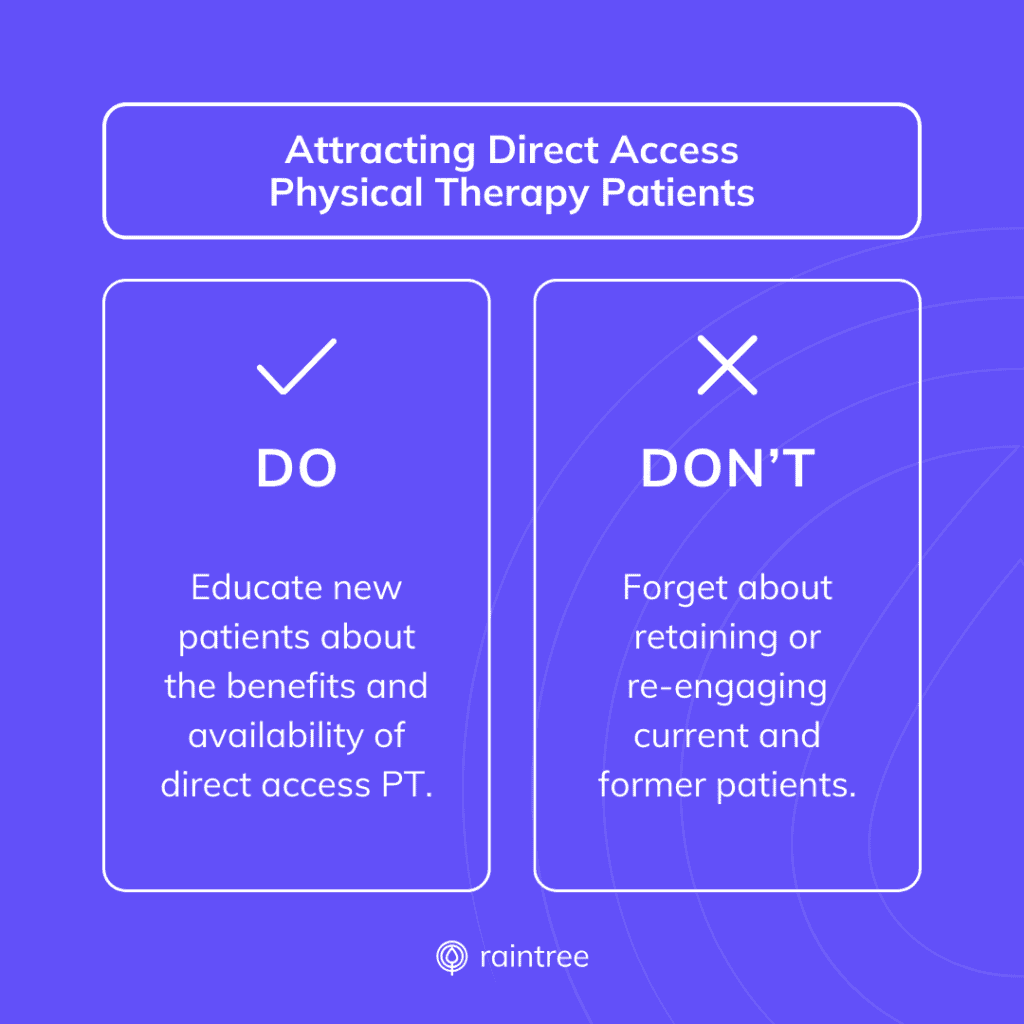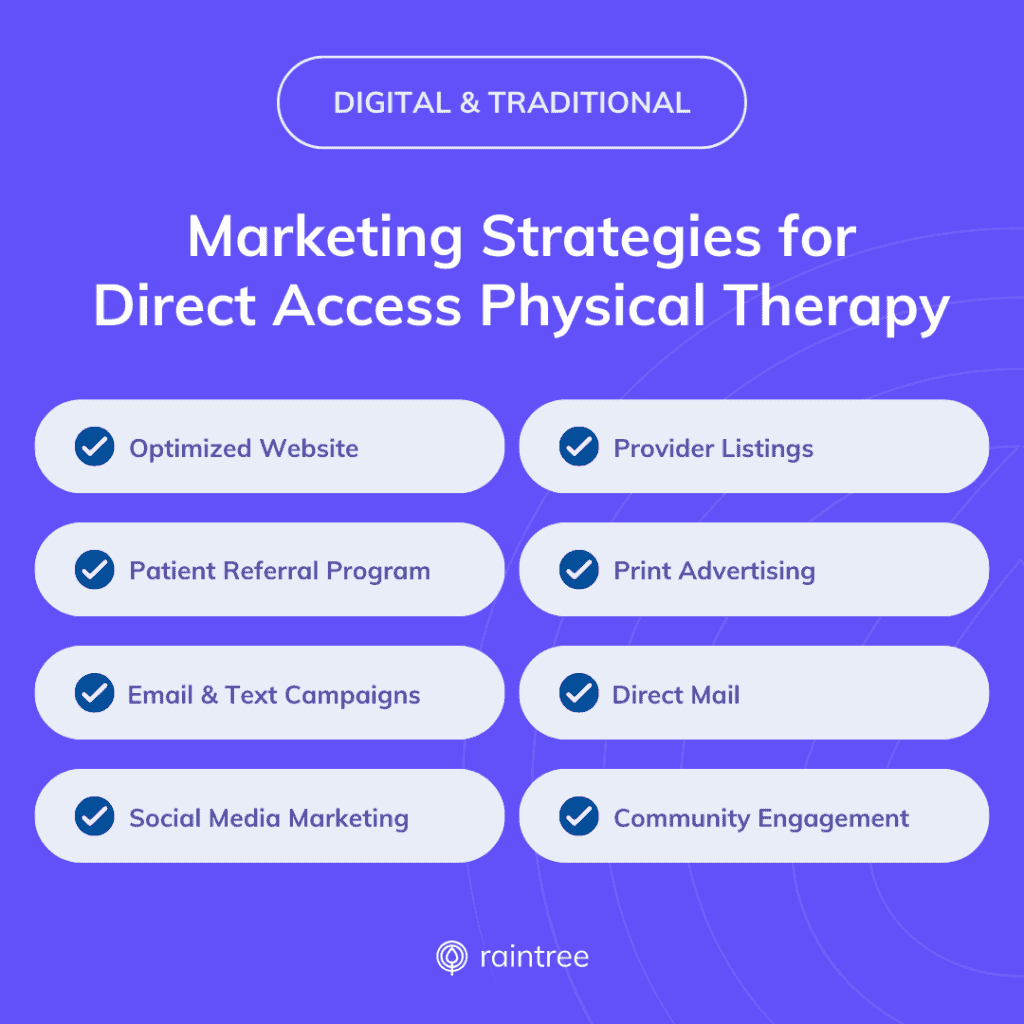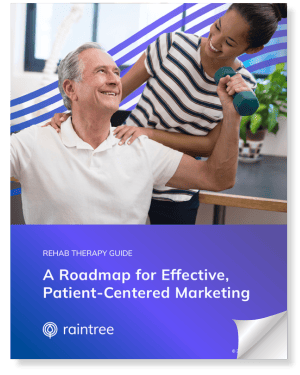Ease of intake is one of the fastest-growing factors in attracting and retaining patients according to a recent Consumer Experience Trends in Healthcare report.
Now that direct access laws for PT are the norm across the U.S., the path from pain to recovery is more straightforward than ever. Still, many patients don’t even know it’s an option. For that reason, marketing directly to patients will require campaigns that can both educate and attract your target audience.
Use these marketing strategies for direct access physical therapy to help your practice stay competitive and cast a wider net in the sea of potential patients.
Knowing Your State and Insurance Carrier Direct Access Policies
Since about 2015, every U.S. state has implemented direct access laws. But that doesn’t mean every state handles it the same way. And many insurance carriers still impose limitations on patients’ ability to seek care without a script.
It’s important to tailor your direct access marketing to its availability for patients in your area and in network with your accepted insurances—especially if your practice has grown across state lines.
How to Attract Direct Access Patients
The best patient acquisition strategies strike a balance between attracting new patients and nurturing existing relationships. Why? Because focusing on both acquisition and retention ensures sustainable growth and a solid patient base.
So without further ado, let’s outline some strategies for bringing in new patients and re-engaging current ones.
Reaching New Patients
Bringing in new patients is the main road to growing a successful PT practice. To reach patients who haven’t heard of your practice yet, PT marketers can use a combination of paid and organic marketing efforts. Your new patient marketing plan should also include strategic partnerships with local businesses. (We’ll share some best practices below!)
Re-Engaging Current Patients
Patient needs evolve over time, especially for those managing chronic conditions or experiencing deteriorated mobility with age. Whether they’ve completed treatment or fallen out of adherence—re-engaging current patients can lead to lasting patient-provider relationships and boost the patient’s lifetime value to your practice.
Some tips for re-engaging current patients include:
- Setting up automated follow-up communications throughout treatment and when patients miss appointments.
- Talking to patients at discharge to remind them that their insurance may allow them to return to care without a physician referral, should it be necessary in the future.
- Checking in with patients at regular intervals via automated text or email, to determine whether they are experiencing new symptoms, and should request an appointment.

Digital Marketing Strategies for Direct Access Physical Therapy Patients
Every single day, about 6 million people in the U.S. go searching online for medical information. Your practice needs to be ready to educate patients and help them take the next step toward better health with a self-referral.
These first five marketing strategies for direct access physical therapy practices are all about digital marketing and building your brand online.
1. Showing Up in Search Results
Your practice website is your digital welcome mat, and a starting point for patients who are looking for a new physical therapy clinic. In order to show up among the top results on search engines like Google, your site design should be user-friendly, accessible, SEO optimized, and mobile friendly.
💯 Practical Advice
Add a page on your website specifically about direct access physical therapy. On that page, you can answer common questions and let people know how to initiate self-referrals.
To capture even more local traffic, pay attention to your business’s online listings, like your Google Business profile. Accurate and updated information on these platforms can help you reach patients searching for care in your area.
2. Patient Referral Incentive Programs
What’s one of the best ways to build trust with future patients? When your current ones act as ambassadors for your brand. To boost patient-to-patient referrals, you can create an online form that makes it easy for existing patients to invite friends and family to your practice. Incentives such as raffle prizes can create a win-win situation where your patients feel appreciated, and your practice gains new clients.
3. Modern Communications Tools for Email and Text
Modern messaging channels keep you connected with your patients. For example, patient communication software can send appointment reminders, follow-ups, and valuable health tips via text or email. You can also set up a digital newsletter for both current and discharged patients, keeping the connection warm at all stages of the patient journey.
4. Social Media Marketing and Community-Building
Harness the power of social media platforms to connect with your community. Your social media calendar could include a mix of practice updates, patient success stories, health tips, memes, and candid moments to help you build a community of followers. Social media profiles on Facebook and Instagram often show up in search engines results, too, so don’t neglect this opportunity to elevate your online presence.
5. Online Healthcare Marketplaces
Partnering with healthcare marketplaces can expand your practice’s reach. Platforms like ZocDoc connect people who are searching for care with healthcare providers in their network. This makes it convenient for individuals to find and request appointments, and easier for practices to secure new business.
Traditional But Powerful: Offline Physical Therapy Marketing Ideas
Although digital marketing campaigns have risen to prominence, traditional methods still hold sway. The remaining three strategies demonstrate the power of conventional methods for marketing your physical therapy practice.
6. Print Media: Brochures, Business Cards, and More
Research shows that people are better at remembering print ads than digital ones. Professionally designed brochures, tri-folds, or other print advertising can help inform people of their options for seeking out care. Plus, there’s no beating the classic business card, which provides a tangible reminder of your physical therapy business. Modern business cards can even include a QR code to your site or appointment request form.
7. Direct Mail Campaigns
Direct mail campaigns are one of the best ways to reach a a large number of potential patients in specific areas. A relatively low-cost addition to your marketing efforts, direct mail means that your personalized letters or branded postcards arrive right at a prospect’s front door. Of course, it’s harder to quantify the success of these campaigns, so make sure to set up a measurement system that will help you determine the ROI of this tactic. (More on that later!)
8. Events and Community Engagement
Participating in local events and community engagement can boost your practice’s local reputation. Sponsorship of community events, health fairs, or sports tournaments provides opportunities to interact with attendees, share your expertise, and distribute marketing materials. Alternatively, hosting workshops or free health-related events can showcase the value of the services you offer.

Measurement: Is It Working?
The biggest mistake some providers make is not tracking the effectiveness of their marketing tactics.
Practices should proactively and regularly assess the efficacy of their campaigns. This involves calculating marketing efforts’ return on investment (ROI), tracking key performance indicators (KPIs), monitoring patient feedback for satisfaction and insights, and implementing continuous improvement processes over time.
Simple metrics for tracking the success of your direct access marketing could include:
- Number of self-referrals per month
- Traffic to your website’s direct access info page
- Participation rates in your word-of-mouth referral program
- Conversions in a patient re-engagement email campaign

Next Steps: Supercharge Your Strategy
The best practice marketing strategies are designed to create strong relationships and facilitate great patient experiences, even before the first appointment.
Raintree’s patient engagement suite supports rehabilitation therapy private practices with digital intake tools, two-way communications, a powerful patient portal, telehealth, lead tracking, and more.
Get in touch and discover how Raintree’s practice management and EHR software can help you grow your practice.
Read the Guide:
A Roadmap for Effective, Patient-Centered Marketing
Frequently Asked Questions
What is direct access in physical therapy?
All 50 states have laws on the books that provide some form of direct access physical therapy. Direct access means that patients have the right to directly seek specialist services without a physician's referral or prescription. This change lowers barriers and reduces delays by creating a more straightforward path to physical therapy.
How did direct access physical therapy become available?
Advocacy efforts within the physical therapy field lobbied for legislative changes that led to the implementation of direct access laws in the U.S. Through industry-wide initiatives and professional organizations' lobbying, state legislatures began introducing laws supporting direct access and recognizing the competence of physical therapists to evaluate and treat patients autonomously.
What are the benefits of direct access for physical therapy patients?
Self-referral allows patients to seek specialized care without intermediaries and affords them freedom and control over their healthcare journey. Some studies indicate other benefits like lower overall healthcare utilization and less time off work compared to care directed by a primary care physician. Additionally, a recent literature review concluded that direct access is an effective alternative to physician-first care in terms of "patient safety, satisfaction, access to care, efficiency, healthcare utilization, and potential cost savings."
Why is direct access important for physical therapists?
Direct access laws can help boost the financial health of physical therapy practices. Recent data underscores the economic advantages of direct access appointments. For example, a systematic review and a meta-analysis both concluded that direct access is more cost-effective than the physician-first model. Likewise, direct access reduces barriers to care, so clinics advertise directly to patients rather than waiting for referrals. This gives practice owners and marketers more control over the growth of their practice.



